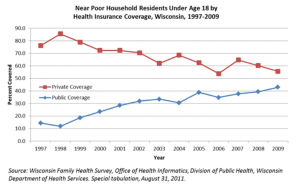Does Public Health Coverage Augment Private Coverage or Crowd It Out?
Expansion of government health care programs like Medicaid is sold with the explicit argument that expansion will cover the uninsured. However, expansion may also cause people who are already insured to cancel their insurance or let it lapse so that they can take advantage of a less expensive to them government program. Academic studies of the size of the crowd-out effect arrive at a variety of conclusions ranging from Lo Sasso and Buchmueller’s estimate of a 50 percent crowd-out rate for SCHIP to an 8 percent rate for Dague et al.
Wisconsin runs its own population survey of health coverage. It samples from all Wisconsin households with landline phones (weights adjusted to represent what is known of the cell only population). The response rate is 47 percent, and 2,462 households were interviewed in 2011.
Here are two graphs showing what the survey has found over the last decade. What is most striking is that if the overall rate of coverage has increased, the increase is small. The increase in public coverage of children of about 25 percentage points mirrors a similar loss in private coverage; and the same effect ― but slightly smaller ― is observed in working-age adults.
Whether one likes what has happened to the split between public and private coverage presumably depends upon one’s ideological commitment to government run health care, perspectives on the relative costs of running private or public coverage, perceptions about quality in the two systems, and the equity of various public and private financing mechanisms.




“What is most striking is that if the overall rate of coverage has increased, the increase is small.”
This is interesting how it shows many people react to ACA in letting go of their private insurance in lieu of receiving government run Medicaid care or heavily subsidized insurance.
I think the fact that overall coverage only increased minimally, public coverage is crowding out private, as people are dropping private insurance to go enroll in ObamaCare or expanded Medicaid.
Crowd-out depends on many factors; and is different among diverse populations. Cutler and Gruber found rates are were 50%-75% for Medicaid expansions in the early 1990s. Gruber and a colleague later estimated crowd-out rates of 60% for SCHIP. As I recall, under certain conditions — I believe it was when the mothers could get coverage along with their children — crowd-out rates could surpass 80%. Frakt would probably argue with my interpretation, but he and Pizer found similarly high rates were possible for childless working adults — the population for which eligibility is being expanded.
To paraphrase a tenant of economics: more is preferred to less; and people prefer free to things that cost money.
“…people prefer free to things that cost money.”
And that is why many people are going to ObamaCare and Medicaid plans. Most people will choose to be on something low to no cost. It doesn’t matter to the consumer as long as someone else foots the bill.
And this, despite the fact that finding physicians who will accept Medicaid is going to be harder to do.
Yeah good luck finding doctors who are willing to take smaller reimbursements just out of the kindness of their hearts.
Medicaid Mills run patients through the exam room like cattle in a corral. Medicaid patients are probably used to milling around in large waiting rooms. Maybe, they could have group appointments. The doctor could walk out into the waiting room…
“All y’all who have the diabetes raise your hand. OK, that’s half the room — now listen up! You need to stop eating candy bars and drinking Cokes. You need to lose about 50 pounds. Check your blood sugar daily, and take your medicine daily.
The nurse will hand you your prescription on the way out after you sign the roll sheet so I can bill Medicaid for this office visit.”
So that’s what its like being on Medicaid?! You can’t say they aren’t efficient!
Crowd-out is a very complex issue. I know that the Rand Corporaton has done detailed studies on this but i do not know how to find them.
It is hard to believe that 80-90 per cent of near poor adults had private health insurance in 1997. I can only guess that large unionized manufacturing companies like Briggs and Stratton or Delphi or GM offered health insurance to all their workers.
A great deal of employment growth since 1997 has been in fast food, hospitality, hair care and other businesses that almost never offer health insurance to their low wage employees.
This did NOT hapoen because of Medicaid. In virtually all states, childless adults were barred from Medicaid until 2014.
There is a lot of correlations in this subject, but I would be terribly cautious about any theories of causation.
I would not be. When the government offers people the option of socializing costs, we tend to take it. And we tend to tolerate a lot if inefficiency as a result.